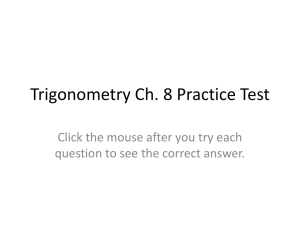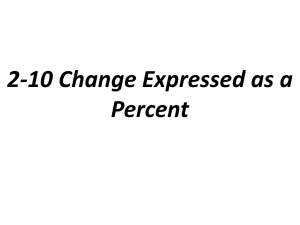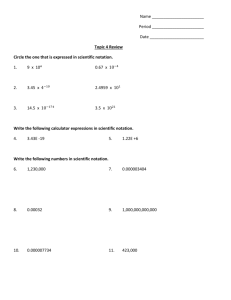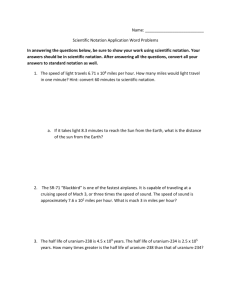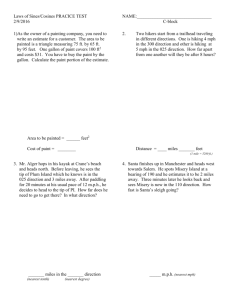Scientific Notation
advertisement
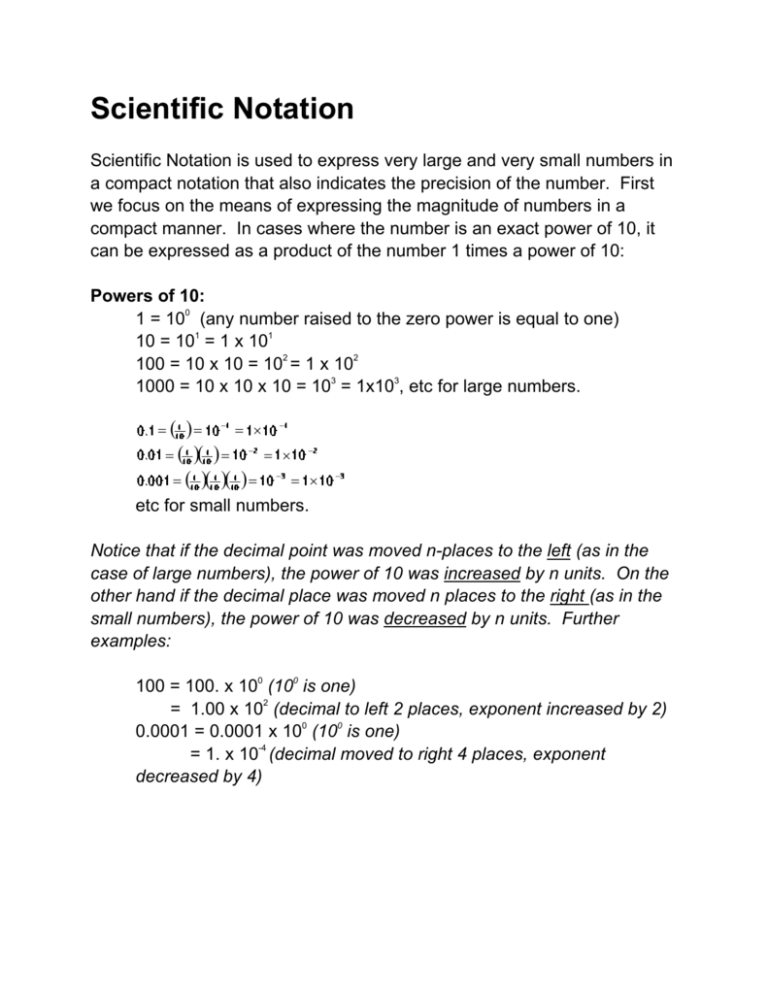
Scientific Notation Scientific Notation is used to express very large and very small numbers in a compact notation that also indicates the precision of the number. First we focus on the means of expressing the magnitude of numbers in a compact manner. In cases where the number is an exact power of 10, it can be expressed as a product of the number 1 times a power of 10: Powers of 10: 1 = 100 (any number raised to the zero power is equal to one) 10 = 101 = 1 x 101 100 = 10 x 10 = 102 = 1 x 102 1000 = 10 x 10 x 10 = 103 = 1x103, etc for large numbers. =( )= − = × − = ( )( ) = − = × = ( )( )( ) = − = − × − etc for small numbers. Notice that if the decimal point was moved n-places to the left (as in the case of large numbers), the power of 10 was increased by n units. On the other hand if the decimal place was moved n places to the right (as in the small numbers), the power of 10 was decreased by n units. Further examples: 100 = 100. x 100 (100 is one) = 1.00 x 102 (decimal to left 2 places, exponent increased by 2) 0.0001 = 0.0001 x 100 (100 is one) = 1. x 10-4 (decimal moved to right 4 places, exponent decreased by 4) Numbers that are not simple powers of 10: Recognize that any number is a product of a power of 10 and a factor. For example, 400,000 = 4 x 100,000 = 4 x 105 0.007 = 7 x 0.001 = 7 x 10-3 Just as above, move the decimal place sufficiently to produce a number between 1 and 10, and then adjust the power of 10 accordingly. 430,000 = 430,000 x 100 = 4.30000 x 105 (decimal moved 5 places left; exponent increased by 5) 0.00000558 = 0.00000558 x 100 = 5.58 x 10-6 (decimal moved 6 places to right; exponent decreased by 6) The second issue addressed by scientific notation is to provide an indication of how precisely a number is known. The last figure maintained after the decimal place is the first one that is somewhat uncertain. For example, if a cross country trip covers 3,000 miles and the distance is known to within 10 miles, then only three of these figures are significant. (That is the distance could be about 10 miles longer, 3010, or possibly 10 miles shorter, 2990). This is represented in scientific notation by 3.00 x 103. If the trip had only been known to within about 100 miles (as large as 3100 or as small as 2900 miles), it would be represented as 3.0 x 103. That is, the last place maintained in scientific notation is the first one that becomes somewhat indefinite when the uncertainty of the measurement is included. Without this convention we wouldn’t know whether 3,000 miles was known to the nearest thousand, nearest 100, nearest 10, or nearest 1 mile. For very large numbers, this is essential. The scientific notation makes this clear. In the same way, if a small distance is measured to the nearest thousandth of an inch, it might be given as 0.045 inch. In scientific notation, we would express this as 4.5 x 10-2 inch, with the notation indicating it was actually known to the nearest 0.001 inch. If, on the other hand, the measurement was known nearest 10,000 of an inch, it might given as 0.0450 and would be expressed in scientific notation as 4.50 x 10-2 inch. If very different units are chosen, the number of figures in scientific notation should be about the same. For example if the cross country trip was 3,000 miles, measured to the nearest 10 miles, we could express it as 15,840,000 feet measured to nearest 52,800 feet, or as 190,080,000 inches measured to the nearest 633,600 inches (the equivalent of 10 miles). In scientific notation, with correct precision shown: 3,000 miles = 3.00 x 103 miles (to the nearest 10 miles) 15,840,000 feet = 1.58 x 107 feet (to nearest 10 miles or nearest 52,800 feet) 190,080,000 inches = 1.90 x 108 inches (to nearest 10 miles or nearest 633,600 inches; note that the original number was rounded in the conversion) In the above example, it would not have been unreasonable for you to quote 4 significant figures after conversion of units from miles to feet or inches. In this particular case, the uncertainty in the measurement is right on the borderline between 3 and 4 figures.

